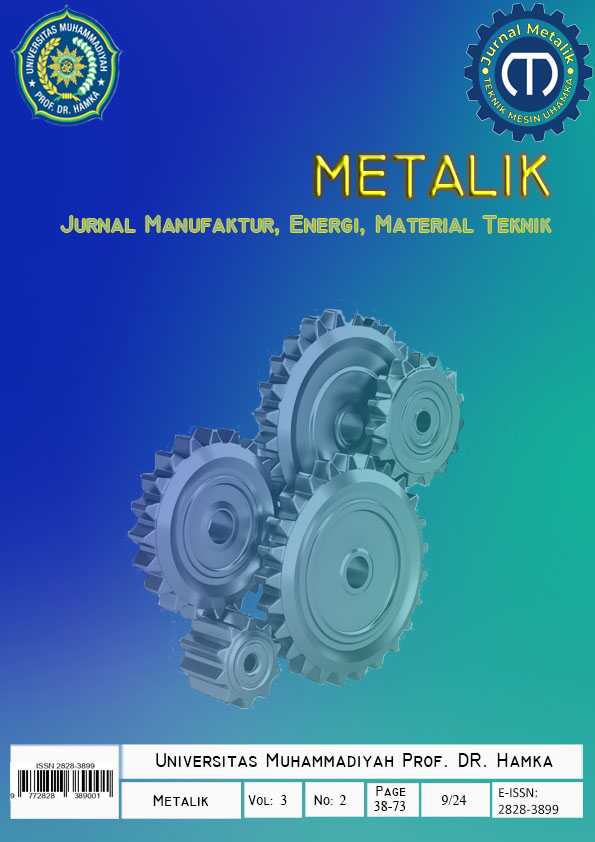Pengaruh Pendinginan terhadap Daya Keluaran dan Efisiensi Sistem Panel Surya
DOI:
https://doi.org/10.22236/metalik.v3i2.16777Keywords:
Photovoltaic, Cooling, Northward Position, EfficiencyAbstract
Salah satu aplikasi energi terbarukan yang memanfaatkan energi matahari adalah panel surya atau sistem fotovoltaik. Kinerja sistem fotovoltaik dipengaruhi oleh besarnya intensitas cahaya matahari dan temperatur permukaan panel surya itu sendiri. Penelitian ini mencoba mengatasi masalah temperatur tersebut dengan membuat sistem pendingin yang dirangkai pada bagian bawah panel surya. Tujuan penelitian yang ingin dicapai adalah untuk mendapatkan daya keluaran dan efisiensi sistem fotovoltaik yang maksimal dengan memasang sistem pendingin. Sistem fotovoltaik diekspos ke arah utara sepanjang hari. Sistem fotovoltaik tanpa menggunakan sistem pendingin dan yang menggunakan sistem pendingin dioperasikan dengan waktu pengukuran parameter yang sama. Parameter yang diukur adalah intensitas cahaya, kecepatan angin, debit air, temperatur lingkungan, temperatur panel surya, temperatur pendingin, tegangan listrik dan arus listrik. Hasil dari penelitian menunjukkan bahwa daya keluaran (P_out) tanpa sistem pendingin sebesar 44,439 watt dan daya keluaran (P_out) dengan sistem pendingin sebesar 49,181 watt. Efisiensi sel surya tanpa sistem pendingin sebesar 13,541% dan sel surya dengan sistem pendingin sebesar 14,162%. . Hal ini menunjukkan bahwa sistem pendingin dapat meningkatkan kinerja sel surya.
One of the applications of renewable energy that utilizes solar energy is solar panels or photovoltaic systems. The performance of the photovoltaic system is influenced by the amount of sunlight intensity and the surface temperature of the solar panel itself. This research tries to solve the temperature problem by making a cooling system that is strung at the bottom of the solar panel. The research objectives to be achieved are to obtain the maximum output power and efficiency of the photovoltaic system by installing a cooling system. The photovoltaic system is exposed north throughout the day. Photovoltaic systems without the use of cooling systems and those using a cooling system are operated with the same parameter measurement time. The parameters measured are light intensity, wind speed, water discharge, environmental temperature, solar panel temperature, cooling temperature, electric voltage and electric current. The results of the research show that the output power (P_out) without a cooling system of 44.439 watts and an output power (P_out) with a cooling system of 49.181 watts. The efficiency of solar cells without a cooling system was 13,541% and a solar cell with a cooling system was 14,162%. . This shows that the cooling system can improve the performance of solar cells.
Downloads
References
Y. S. Rifky, Gaos, “Pengembangan Model Pendingin Kabin City Car Bertenaga Surya Menggunakan Photovoltaics ( PV ) dan Thermoelectric ( TEC ),” vol. 10, no. 1, pp. 34–40, 2019.
Y. Chu, “Review and Comparison of Different Solar Energy Technologies, Global Energy Network Institute (GENI), 2011,” no. August, p. 22, 2011.
U. Wibawa and A. Darmawan, “Penerapan Sistem Photovoltaik Sebagai Suplai Daya Listrik Beban Pertamanan,” J. EECCIS, vol. 2, no. 1, pp. 26–37, 2008.
R. Pido, S. Himran, and Mahmuddin, “Analisa Pengaruh Pendinginan Sel Surya Terhadap Daya Keluaran dan Efisiensi,” Teknologi, vol. 19, no. 1, pp. 31–38, 2018.
E. Adhi Adriono, warsito, M. Y. Nugroho, O. Oding, and B. Winardi, “Dipo Pv Cooler, Penggunaan Sistem Pendingin Temperatur Heatsink Fan Pada Panel Sel Surya (Photovoltaic) Sebagai Peniingkatan Kerja Energi Listrik Baru Terbarukan,” Transient J. Ilm. Tek. Elektro, vol. 2, no. 3, pp. 499–503, 2013.
H. Isyanto, Budiyanto, Fadliondi, and P. G. Chamdareno, “Pendingin untuk peningkatan daya keluaran panel surya,” Semin. Nas. Sains dan Teknol. 2017, no. November, pp. 1–2, 2017.
P. Taylor and M. M. Kostic, “Energy : Global and Historical Background Energy : Global and Historical Background,” Encycl. Energy Eng., no. July 2015, pp. 1–15, 2008.
C. J. Chen, Physics of Solar Energy. 2011.
A. E. Putra, R. Rifky, and A. Fikri, “Pemanfaatan Panas Buang Atap Seng dengan Menggunakan Generator Termoelektrik sebagai Sumber Energi Listrik Terbarukan,” Pros. Semin. Nas. Teknoka, vol. 3, no. 2502, p. 38, 2019.
E. N. S. Lewis, “Basic Research Needs for Solar Energy Utilization,” 2005.
B. Ramadhani, “Dos & Don ’ ts,” p. 277, 2018.
S. Samsurizal, A. Makkulau, and C. Christiono, “Analisis Pengaruh Sudut Kemiringan Terhadap Arus Keluaran Pada Photovoltaic Dengan Menggunakan Regretion Quadratic Method,” Energi & Kelistrikan, vol. 10, no. 2, pp. 137–144, 2019.
P. Jayakumar, “Solar Energy Resource Assement Handbook,” System, no. September, pp. 1–117, 2009.
A. Del Amo, A. Martínez-Gracia, A. A. Bayod-Rújula, and J. Antoñanzas, “An innovative urban energy system constituted by a photovoltaic/thermal hybrid solar installation: Design, simulation and monitoring,” Appl. Energy, vol. 186, pp. 140–151, 2017.
B. H. Purwoto, “Efisiensi Penggunaan Panel Surya Sebagai Sumber Energi Alternatif,” Emit. J. Tek. Elektro, vol. 18, no. 01, pp. 10–14, 2018.
S. A. Kalogirou, Solar Energy Engineering Processes and Systems Second Edition Soteris. 2018.
Asrori, Imam Mashudi and Suyanta, “Pengujian Rasio Kinerja Instalasi Panel Surya Tipe Silikon–Kristal pada Kondisi Cuaca Kota Malang,” J. Energi Dan Teknol. Manufaktur, vol. 2, No.2, no. p-ISSN: 2620-8741, pp. 11–18, 2019.
T. A. Rizal, M. Amin, and P. H. Saputra, “Kaji Eksperimental Pendinginan Panel Surya Menggunakan Media Udara,” Jurutera, vol. 01, no. 01, pp. 027–030, 2014.
H. A. S and M. Bastomi, “Analisis Pengaruh Perubahan Temperatur Panel Terhadap Daya Dan Efisiensi Keluaran Sel Surya Poycrystalline,” Din. J. Ilm. Tek. Mesin, vol. 11, no. 1, p. 33, 2019.
R. Alfanz, F. M. K, and H. Haryanto, “Rancang Bangun Penyedia Energi Listrik Tenaga Hibrida ( PLTS- PLTB-PLN ) Untuk Membantu Pasokan Listrik Rumah Tinggal,” Setrum, vol. 4, no. 2, pp. 34–42, 2015.
ono wihara and m Agus, “Analisis Sistem Pendingin engine,” pp. 1–7.
M. S. Loegimin, B. Sumantri, M. A. B. Nugroho, H. Hasnira, and N. A. Windarko, “Sistem Pendinginan Air Untuk Panel Surya Dengan Metode Fuzzy Logic,” J. Integr., vol. 12, no. 1, pp. 21–30, 2020.
A. Aldossary, S. Mahmoud, and R. Al-Dadah, “Technical feasibility study of passive and active cooling for concentrator PV in harsh environment,” Appl. Therm. Eng., vol. 100, no. February, pp. 490–500, 2016.
S. A.R, “Sistem Pendingin Pasif untuk Meningkatkan Daya Keluaran Panel Sel Surya,” 2019.
Downloads
Published
How to Cite
Issue
Section
License
Copyright (c) 2024 METALIK : Jurnal Manufaktur, Energi, Material Teknik

This work is licensed under a Creative Commons Attribution-NonCommercial 4.0 International License.
















